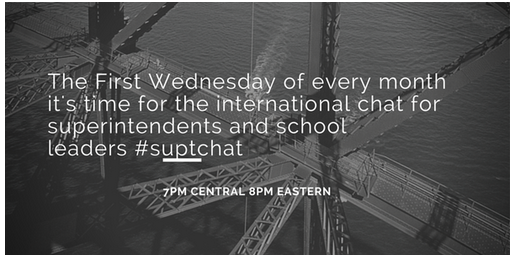“The future belongs to those who see possibilities before they become obvious.”
– John Sculley, Business Executive
I originally published this for Discovery Education’s Educator Community Blog:
http://blog.discoveryeducation.com/blog/2015/06/17/social-media-and-the-connected-school-district/

Times have changed. Ten years ago, in 2005, superintendents used the U.S. Postal Service to support communication and leadership. They used paper memos and inter-office envelopes and even voicemail. Communication today is instant and immediate. Today’s superintendent is connected 24/7 and is able to communicate with blogs, audio, video, text messaging, e-mail, and any number of social media applications like Twitter, Facebook, Instagram, Remind, Snapchat, etc. The past ten years have shown significant changes in terms of consumption of information and “fingertip” access. Yes, times have changed. Communication has changed, but the importance of communication in support of leadership and innovation remains the same. Today’s superintendent knows how to leverage the power of technology to harness effective and impactful communication. Are you a superintendent of today, or yesterday?
During in-services and meetings I have shared videos on YouTube in the “Did You Know” series where they show statistics about the number of emails, members of Facebook, technology impacts of the modern world, etc. The messages from these videos also support and explain and define this generation’s ubiquitous relationship with  technology. As I write in 2015 it is difficult to imagine that it has only been five years since people first began using iPads. Now it is impossible to go anywhere and not see people using iPads. How has our world changed so much that a device no one knew about six years ago, introduced five years ago, is now in the hands of more than 200 million people?
technology. As I write in 2015 it is difficult to imagine that it has only been five years since people first began using iPads. Now it is impossible to go anywhere and not see people using iPads. How has our world changed so much that a device no one knew about six years ago, introduced five years ago, is now in the hands of more than 200 million people?
The iPad is a perfect representation of our culture’s demand for constant connectivity and yet despite these profound and deeply rooted changes in society, in some school systems the top leadership still does not understand or value current methods of communication. Their relative ignorance about social connectivity can become quite detrimental to a school system in search of change, innovation, and leadership. Students today will be competing for jobs that do not yet exist. Students today will be connecting in ways that generations of senior leadership do not yet understand. It is incumbent upon senior level leadership to connect, to open up, to model, to essentially lead in a culture of connected communication.
The Connected Educator
 The “connected educator” is a hot topic today. These are the educators and educational leaders who are learning and growing through multiple digital learning networks. These personal and professional learning networks allow people at various levels to share links, blogs, journals, research, tips, tricks, etc. These networks allow for virtual relationships to develop between and among professionals at many levels. These networks are the wave of the present and future — not the past. These networks are revolutionizing professional development and conferences. Now terms like “un conference” or “ed camp” are becoming the norm. Now “experts” — meaning professionals at every level — are facilitating sessions and sharing creativity.
The “connected educator” is a hot topic today. These are the educators and educational leaders who are learning and growing through multiple digital learning networks. These personal and professional learning networks allow people at various levels to share links, blogs, journals, research, tips, tricks, etc. These networks allow for virtual relationships to develop between and among professionals at many levels. These networks are the wave of the present and future — not the past. These networks are revolutionizing professional development and conferences. Now terms like “un conference” or “ed camp” are becoming the norm. Now “experts” — meaning professionals at every level — are facilitating sessions and sharing creativity.
Here is what connected educators doing that others are not:
- Organizing the entire community around specific and focused goal areas.
- Building relationships online and in person.
- Seeking feedback, sharing feedback and incorporating feedback into actions.
- Staying focused on the big picture, medium picture, and details.
- Reaching beyond the “walls” of the District and community to learn, grow, and share.
- Responding to inquiries (press, parent, student, union) in timely and respectful manner.
- Using technology as an accelerator for teaching, learning, and leading.
- Measuring culture and deliberately working to improve organizational culture.
- Keeping students, staff, and community at the forefront of all decision-making.
Sharing and Connecting – Twitter as a Tool for Growing Capacity
The District’s journey with technology had begun in earnest in 2005 but the managed IT services were outsourced 100% and most of the advice about filtering and site blocking was coming from non educators. As a result, the District was not allowing teachers to harness the power of technology as an accelerator for connecting until my team  and I came on board. One of my first executive actions was the unblocking of Twitter and the encouragement to use it and other social media channels for professional growth and increased teaching capacity.
and I came on board. One of my first executive actions was the unblocking of Twitter and the encouragement to use it and other social media channels for professional growth and increased teaching capacity.
Twitter is perhaps the most powerful and meaningful social communication tool in the market today. It provides networking, learning and growth and supports the value of communication, collaboration, and networking. This free tool connects leaders and learners instantly with text, imagery, and video. Best of all, Twitter chats offer free professional learning in a venue where status and title are of little importance compared to the value of a great idea.
On a personal level, social media tools have allowed me to solve a real challenge and opportunity in the school district where I serve. Our teachers are provided with a limited amount of planning time coupled with some professional collaboration time, but most of that time ends up being used as adult focused learning time. Discussion about teaching and learning and planning for teaching and learning take place in earnest but tangible examples of what learning looks like and what the results of innovation looks like were not taking place in those meetings. Then came Twitter. Opened and un-blocked on July 1, 2013 (the day I started), Twitter was used to solve this problem of disconnection. Through the use of our District hashtag #Engage109, teachers are now able to show with pictures, videos, links, text, what it is that learning looks like and what innovation means in real life and in real time. Social media has allowed for “wall dropping” – the walls between us no longer inhibit connections! Social media is taking connectivity to levels never before imagined.
Twitter allows for cross-country collaboration as well. For example, a superintendent colleague of mine in Pennsylvania sent me a Tweet and asked if I knew of a 1st grade teacher willing to connect with a 1st grade teacher in his district. So I sent out a Tweet using #Engage109 and, lo and behold, we found a match! It is amazing that,  through Twitter, superintendents in different states are able to connect educators in ways never before possible. Through actions and deliberate methods, we are creating a culture of connectivity! Whether it is through Twitter, Facebook, Instagram, Voxer, blogging, Remind, email, video messaging, or text messaging, communication best practices demand our attention as leaders so that we can tell our stories, engage our communities, inspire our students and staff, and empower each other to learn and grow each day.
through Twitter, superintendents in different states are able to connect educators in ways never before possible. Through actions and deliberate methods, we are creating a culture of connectivity! Whether it is through Twitter, Facebook, Instagram, Voxer, blogging, Remind, email, video messaging, or text messaging, communication best practices demand our attention as leaders so that we can tell our stories, engage our communities, inspire our students and staff, and empower each other to learn and grow each day.
Reflections and Suggestions
These past few years have been explosive in terms of instructional, educational, and operational advances in technology tools. Here are some ideas and suggestions to get started using social media to communicate!
Stop and reflect on the central ideas of this post and think about how you will implement one or more of the suggestions. Ask yourself:
- Are you using any technology to connect?
- Have you experimented with Twitter?
- Do you write an article in your local newspaper?
Understand how your story and your experiences shape the lens with which you view the world and your leadership. Communication is best when it starts with listening. Listen to understand and you’ll connect powerfully. Understand how technology is about people not devices. Understand that connecting as an educator is all about the connecting.
Plan to use technology to connect.
Commit to using Twitter or to writing a blog or to writing an article in the local newspaper. Plan to connect and you will. Deliberately plan to listen without distractions.
Think of three take-aways from this blog post you will present at your next leadership team meeting, write them down – have you acted on them yet?
Chat. Pick an edchat, like #suptchat or a state edchat and participate for an hour — if you do this regularly, make it a point to respond to questions. If you have not yet done this, now is the time to experience a digital form of professional development.
